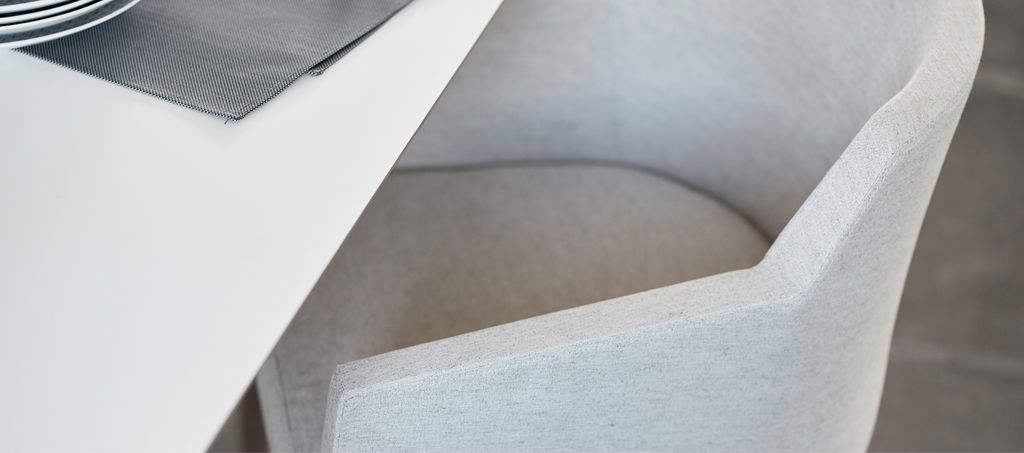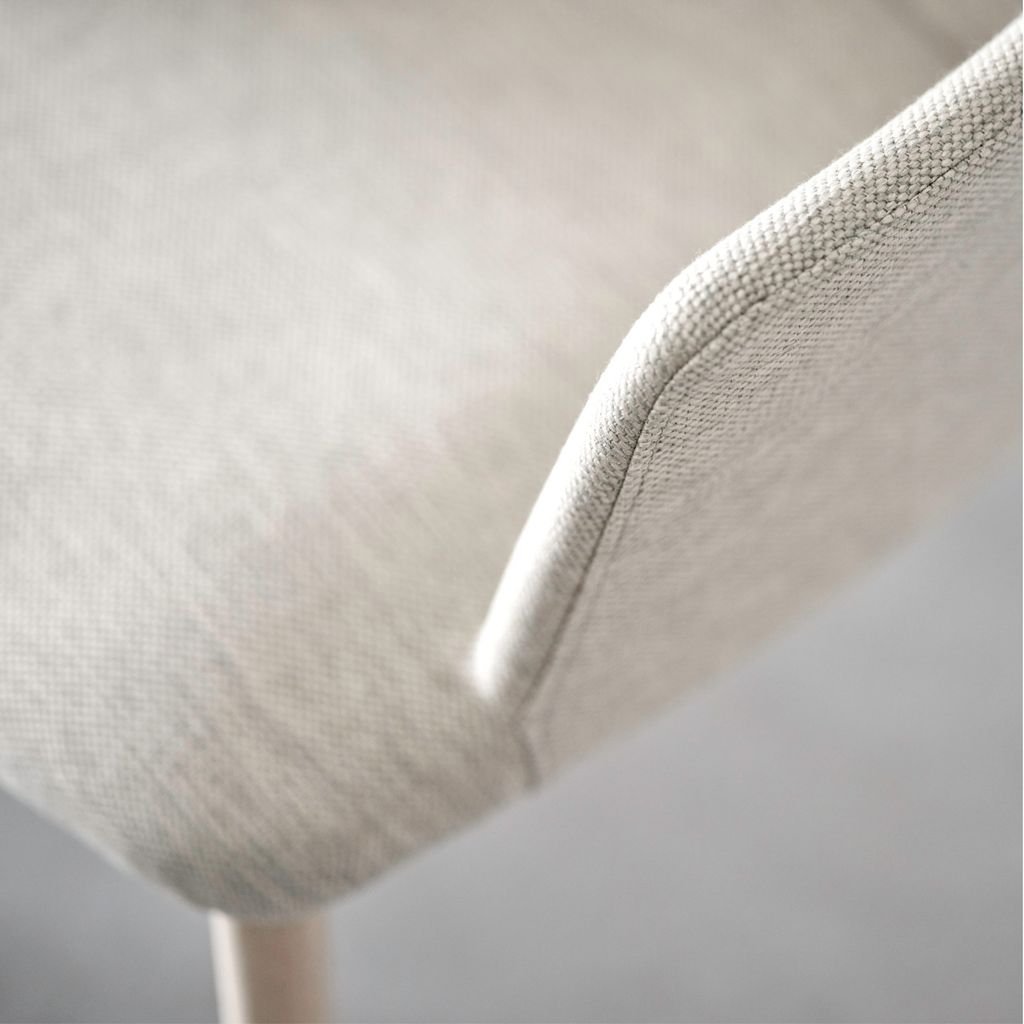Hints and tips for cleaning a chair in fabric

A stain on the fabric upholstery of your Mobitec chair?
No reason to panic. Follow our instructions to clean your chair upholstered in fabric according to the type of stain. In most cases, a little elbow grease and conventional cleaning products will suffice to clean the stain from your chair.
How to clean a chair upholstered in fabric
• If the cover of your chair can be removed, remove it and check the washing and maintenance instructions on the label of the cover. In some cases, you can simply put it in the washer.
• First of all, try to determine the origin and nature of the stain so that you can proceed with the appropriate treatment (which you can find by referring to the list below).
• Dust the seat with the soft brush of the vacuum cleaner to work on a clean surface.
• Apply the stain remover on a clean cloth; never directly on the fabric.
• Test the stain remover on a less visible area of your chair first.
• Always rinse the area after applying the stain remover.
• After applying the stain remover and rinsing, always clean the entire area of the fabric upholstery of the chair. Local treatment risks leaving a halo.
Treatment per type of stain
A) Stain of unknown origin
- Rub with 1 cup of hot water + 2 table spoons of sodium bicarbonate
- Stubborn stain: once the fabric has dried, dab with turpentine
- White fabric: dab with an anti-rust product or oxygenated water
B) Stain of known origin
Chocolate stain
- Cold water
- Engrained stain: scratch then dab with soapy water
- If that doesn’t work: benzine or warmed up glycerine or diluted ammonia or white vinegar
Fruit or vegetable stain
- Natural fibres: water (1/2) + alcohol (1/2) then white vinegar diluted 50%
- Synthetic fibres: soapy water then dab with a wet cloth + 1 drop of 70° alcohol.
- White or stain resistant fabric: scarcely bleached water
- Wool: a little vinegar. Make sure you rinse as promptly as possible, even if you have to start over.
- Red fruit: lemon juice (rinse well!)
- Orange: warmed up glycerine
Grease stain
- Stain still wet: sprinkle talc powder or flour
- Dry stain: apply sheets of absorbing paper then go over it with a hot iron. Change the paper when it is dirty. Dab the remaining traces with a cloth soaked with diluted ammonia.
- Silk: sprinkle talc powder then brush gently
- Wool: Fine China clay
Ketchup stain
- Cold water then white vinegar diluted 50%. Allow to act then soak again
- If that doesn’t work: undiluted vinegar or hot milk
Mustard stain
- Remove any excess with a spoon
- Water + soap then oxygenated water + ammonia
- Highly engrained stain: make stain fade with lemon juice
Egg stain
- Cold water
- Old stain: oxygenated water, slightly diluted
Sauce stain
- Marseille soap scarcely wet. Leave to act for half an hour then rinse.
- Other options: warmed up glycerine or diluted ammonia
- Greasy or sweet sauce: dilute with cold water then rub with glycerine + a drop of liquid soap, or sprinkle sodium bicarbonate or corn starch, brush gently and rinse with hot water. Or prepare a paste with soda ash and water, let act for a quarter of an hour, then rinse with very hot water.
Salad dressing stain
- Stain still wet: sprinkle talc powder, corn starch or sodium bicarbonate. Leave to act then brush gently. Rinse with running water.
Beer stain
- Water-alcohol mix (50%) then water-acetic acid (25%)
- Silk: dab with water + rubbing alcohol mix
Coffee stain
- Warmed up glycerine then wet cloth
- Or rub with Marseille soap scarcely wet
- Or dab with water-alcohol mix (50/50) then white vinegar
- Silk or wool: water + 70° alcohol
Fruit juice stain
- Very hot milk or vinegar or carbonated water. Moisten every 30 minutes until the stain disappears.
- Stubborn stain: rub with glycerine. Leave to act 15 min. then rinse.
Milk stain
- Dab with scarcely diluted ammonia
Soda stain
- Stain still wet: sprinkle flour or Fine China clay, brush then dab with soapy water
- Old stain: dab with rubbing alcohol or diluted ammonia
Tea stain
- Dab with soapy water, rinse with vinegary water then clear water
- Old stain: warmed up glycerine
- Synthetic fibres: lemon juice (rinse well !) or mix white vinegar-90° alcohol or sodium 90° or soda ash
Wine stain
- Wet stain: sprinkle corn starch or Fine China clay, brush then dab with milk, then clean with soapy water. Or wipe with a clean cloth then rub with carbonated water.
- Dry stain: dab with white vinegar
- Stubborn stain: soak with hot milk or vinegar for one hour or more and rinse well.
Humidity stain
- Rub with a paste: 30 gr. of grated white soap + 30 gr. of starch + 15 gr. of fine salt + lemon juice. Rinse then dry with a washcloth or hair dryer (average temperature).
Mildew stain
- Dab with oxygenated water or ammonia. Rinse and dry properly with a washcloth or hair dryer (average temperature).
Rust stain
- Rub with lemon juice + salt then pour wet washing powder and rub.
- Stubborn stain: anti-rust product
- White fabric: oxalic acid (salt of sorrel)
- Synthetic fibres: lemon juice (rinse well!)
Pencil stain
- Bicarbonate + water paste. Leave to act then rinse.
Ink stain
- Soak with milk.
- Stubborn stain: rub with peroxide or lemon juice + salt or toothpaste
- White or stain resistant fabric: dab with 90° alcohol or water + a drop of bleach
- Coloured cotton: dab with water + alcohol vinegar or spray hair spray and wipe immediately; repeat several times.
- Wool: dab with 90° alcohol or 1/3 white spirit + 2/3 cold water mix
- Synthetic fibres: dab with lemon juice
- Cotton or silk: pour heated lemon juice or hot milk on the stain
- Delicate fabrics: glycerine, leave to act 30 minutes then rinse
- Red ink or coloured stain: stump with a thick layer of mustard, leave to act for one hour or two then rinse.
Felt-tip pen stain
- Dab with soapy water then with 90°C alcohol or rub with warm milk or lemon juice
- Wool: dab with lemon juice then rinse well
- Synthetic fibres: water + white vinegar (except on acetate)
- Fluorescent felt tip: soak with milk, rub, start again
Pen stain
- White cotton: lemon juice
- Wool or coloured cotton: dab with acetone or 70° alcohol or rubbing alcohol or lemon juice
- Other materials: vinegar + white spirit mix (50/50) or dab with very hot milk or spray hair spray, and then rinse profusely
Tipp-ex stain
- Scratch then dab with solvent naphtha or clean with water + detergent + and a teaspoon of ammonia
- Or dissolve the stain by dabbing with denatured alcohol, acetone or a lemon-based stain remover
Makeup stain
- Dab with ammonia
- If the stain is greasy: apply sheets of absorbing paper then go over it with a hot iron. Dab the remaining traces with a cloth soaked in diluted ammonia.
- Lipstick: rub with warmed up glycerine, or dab with ether, or dab with a non-greasy makeup removing lotion, or spread butter, scratch then dab with ammonia.
Perfume stain
- Dab with white vinegar or rub gently with glycerine.
Hair dye stain
- Dab with oxygenated water or spray hair spray then wipe with a wet cloth
Varnish stain
- Dab with amyl acetate. Avoid solvents.
Eosine stain
- Cotton or flax: 70° alcohol, rinse with bleached water then with pure water
- Wool or silk: cold water (2/3) + rubbing alcohol (1/3)
- Printed fabric: water (1/2) + 70° alcohol (1/2)
Excrement or vomit stain
- If possible: rinse immediately with warm soapy water.
- Old stain: clean with water + some drops of ammonia or oxygenated water
- Cotton or wool: water + alcohol vinegar
Mercurochrome stain
- Cotton or flax: 90°alcohol, rinse with bleached water then with clear water
- Stain resistant fabric: dab with bleached water
- Printed or coloured fabric: dab with a water (1/2) + 90°C alcohol mix (1/2)
Blood stain
- Stain still wet: water + corn starch/flour/talc powder. Leave to dry, dust. Dab the stain with cold water then rub with the ring of an iron key. Or dab with diluted ammonia, and then oxygenated water.
- Dry stain: dab with oxygenated water
- Stubborn stain: tartaric acid or peroxide or ammonia
- Stain resistant fabric: dilute with physiological serum, then rinse
- Silk: dab with rubbing alcohol
Glue stain
- Glue that is still fresh: remove the excess then dab with white sprit or with a solvent (see manufacturer’s instructions). Or soak with white vinegar then dab with hot water.
- White glue: moisten with hot water, dab with white vinegar
- Cynocrylate glue: dab with white vinegar
- Epoxy glue: scratch with a nail or rub and wash with soapy hot water
- Carpenter’s glue: soapy hot water
- Neoprene glue: dab with acetone
- Polyurethane glue: scratch with a nail or rub the fabric and dab with acetone
- Vinyl or acrylic glue: scratch with a nail or rub the fabric
Putty stain
- Scratch and rub to remove the excess, dab with white spirit or warm white vinegar
Paint stain
- Oil paint: withdraw the excess with a spoon, dab with a solvent like white spirit. If the stain persists: rub with lard, leave to act for a day, then remove with solvent naphtha.
- Water paint: remove the excess with a spoon, wash with cold water + soap.
- Dry paint: dab with rubbing alcohol.
- Gloss paint: dab with solvent naphtha
Plaster stain
- Scratch gently then dab with vinegar
Mud or earth stain
- Leave to dry, brush then wash with soapy water
- Natural fibres: dab with diluted ammonia (1 table spoon for 1 litre water) or water + lemon juice
Cigarette burn stain
- Hot water + warmed up glycerine
- Deeper stains: dab with soda ash paste (1 table spoon) + warm water (1/2 litre)
- White cotton: dab with oxygenated water, rinse with bleached water, then with warm water
- Wool and silk: run nearly dry Marseille soap over the stain, leave to act for a few hours then rinse
Chewing gum stain
- Place a plastic bag filled with ice on the stain, remove the excess with a spoon, remove the grease with a solvent (for example, benzine)
- Or place absorbing paper on the stain then go over it with a hot iron
- Or dab with hot white alcohol vinegar
Polish stain
- Withdraw the excess with a spoon, dab with benzine, turpentine, lighter fuel, white spirit or lemon juice + salt
- Or apply glycerine, leave to act 15 min. then rinse with hot water. If the stain persists: moisten with white vinegar, rinse, apply glycerine again
Candle wax stain
- Scratch with a spoon, place a piece of blotting paper on the stain and apply a hot iron on it. Remove the residual grease with benzine.
Insect and fly speck stain
- White or stain resistant fabric: dab with bleached water
- Delicate fabric: dab with water with slightly ammoniacal water
- Fly speck: clean with soapy water + a little ammonia
Nicotine stain
- Dab with 70° alcohol
Plasticine stain
- Rub then apply 1 or 2 sheets of absorbing paper and go over it with a hot iron. Remove the residual grease with benzine.
- Or rub with scarcely wet Marseille soap, leave to act for an hour, lather and rinse with a sponge
Resin or sap stain
- Apply sheets of absorbing paper, go over it with a hot iron then dab with methylated spirit
- If greasy stain remains: dab with solvent naphtha
Sebum stain (skin or hair)
- Natural fibres: dab with acetone
- Synthetic fibres: dab with soda ash paste + water
- Wool: sprinkle Fine China clay, leave to act and brush gently
- Silk: sprinkle Fine China clay, let it penetrate, leave to act for 2 hours then dust
Iodine solution stain
- Moisten then sprinkle sodium bicarbonate, leave it to settle, rub and rinse
- Or dab with ammonia or oxygenated water



